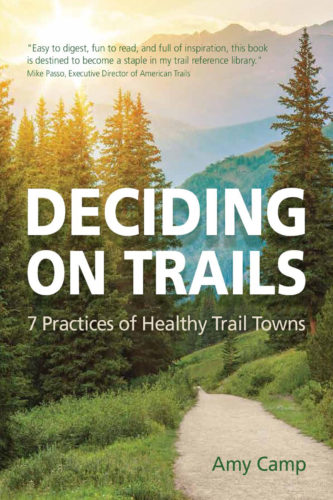By Charles Pekow — It’s not enough to just build, maintain, use, and promote a trail. The greatest level of use and support comes from making a community’s trails an integral part of its culture and economy – becoming a “Trail Town.”
Or as the old African proverb, renewed by Hillary Clinton, might have said, it takes a village to raise a trail to its highest potential.

Author: Amy Camp. 218-page paperback, Plug & Play Publishing, $19.95; Kindle version $9.99, is available on Amazon, ISBN-13 : 979-8578619489
A recent book not only explains that but can serve as an inspiring guide for those who want to expand support for recreational trails and take advocacy to a new level. Deciding on Trails: 7 Practices of Healthy Trail Towns by trails and tourism consultant Amy Camp notes that a successful trail town involves much more than building and maintaining trails, distributing maps, and organizing rides and other activities. The benefits of trails to recreation, transportation and economics have been well documented elsewhere.
The Arbor Foundation runs a Tree City USA with more than 3,400 communities and the League of American Bicyclists has designated more than 500 places Bicycle Friendly Communities. No one has yet started a national Trail Town program, but several states; including Florida, Kentucky, and Michigan; operate statewide programs. But, the book adds, you can take some steps without a formal government or non-profit running a trail culture program. And no one owns a copyright on the name Trail Town should a community decide to call itself one.
The solution is instilling a trail culture. That means much more than supporting businesses. The author writes “those places that value trails only for the anticipated financial benefits miss out on what I think of as the ‘trail magic’ that can touch communities”
Camp describes her own experiences developing a culture along the 150-mile Great Allegheny Passage (GAP) in Western Pennsylvania, where she initially found a “disconnect” between the population and the trail, as non-users couldn’t see how they could benefit from it – a restaurant that closed on the busiest trail days and a C-store clerk who couldn’t direct people to the trail half a mile away. So, a successful initiative must get the whole community involved in welcoming trail users.
When a trail connects multiple communities, it’s vital that the towns work together in numerous ways, regarding everything from signs pointing to the next town, to arranging tours and accommodations for visitors. And note that improving trail conditions outside town helps people get there. “It is better for you to be among a cohort of communities than to do your own thing….” the book warns.
Trail culture can revolve around a single multi-community trail such as GAP, or a series of trails going into and through a town.
A few examples Camp gives: Several waterfront towns in Ontario started bike share programs initially to help boaters explore the areas. Then locals started using the bikes. Elsewhere, art grants to place murals and sculpture located most of the artworks within sight of the trails.
Build a great trailhead. Just adding a welcome sign at the trailhead lets people know the town cares. A kiosk with maps and information about town can help but it’s important to keep it stocked. A bikeshare station or loaner bikes at the trailhead instills culture. “I can imagine hikers who would LOVE to take an easy pedal into town rather than going by foot,” Camp writes. The City of Council, ID even allows approved trail users to camp in a local park and get a bathroom key from the sheriff.
And if a major trail runs through your town, don’t just market tourism to long-distance haulers. People who aren’t up to overnight rides will want a tour or ride through town. If the trail doesn’t go through downtown, build a connector.
The book is very well structured and takes you on a three-part trail starting with a history of trail towns to turning your community into one to where the movement goes from here (even coping with a pandemic). It’s very readable and the author keeps reminding you where you are and why you’re reading. It stops short of being a step-by-step how-to guide, only aiming to send the audience down the right path.
Deciding on Trails: 7 Practices of Healthy Trail Towns
Author: Amy Camp
218-page paperback, Plug & Play Publishing, $19.95; Kindle e-book $9.99, is available on Amazon, ISBN-13 : 979-8578619489.

